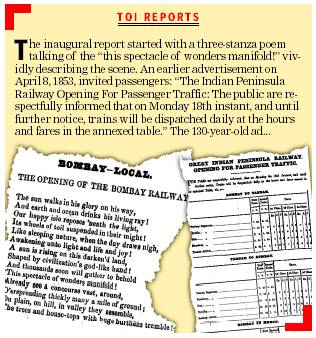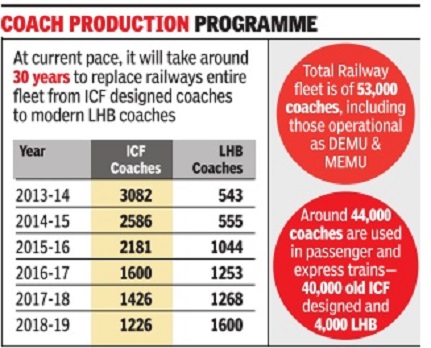Railways, India: 1



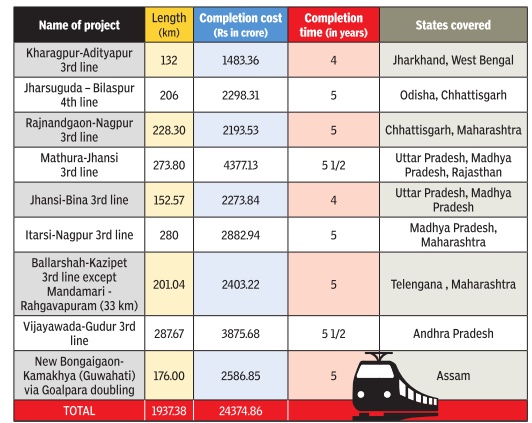

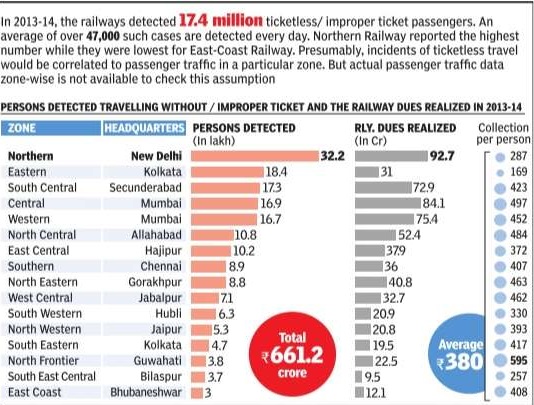
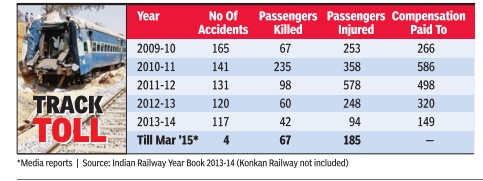

This is a collection of articles archived for the excellence of their content. |
Contents |
History
India’s 1st train: When Sahib, Sindh & Sultan blew steam
The Times of India APRIL 18 | 1853
India’s first passenger train was flagged off on its maiden run between Bori Bunder (later Victoria Terminus, now Chhatrapati Shiva ji Terminus) and Thane — a distance of 21 miles covered in 57 minutes, at 3.35pm on April 16, 1853. Drawn by three engines, Sahib, Sindh and Sultan, the train lurched forward amid fanfare and celebration.
TOI exulted: “Nothing could’ve been more magnificent than the train of 20 enormous carriages with their three stupendous engines, all spick and span new, with the most perfect forms engineering could suggest, and the most beautiful tints taste could impart, occupying a line from first to last on close to four hundred feet.”
The inaugural report noted with pride, “The 16th of April 1853 was, and would long continue to be one of the most memorable days, if not the most memorable day, in the annals of British India.”
“This was not the triumph of nation over nation, of race over race, of man over his fellow man. It was the triumph of mind of matter, of patience and perseverance,” the report quoted a British official at the inaugural function.
Earlier reports and advertisements in the paper had added to the rapidly building excitement over the train’s maiden run. An advertisement on April 8, 1853 quoted traffic manager Roche saying this to prospective riders. “The public are respectfully informed that on Monday, and until further notice, trains will be dispatched daily at the hours and fares named in the annexed table. First class day tickets for the double journey only on the day of issue will be given between Bombay, Tannah and Mahim at three-fourths of the ordinary fare.”
TRACK SETTING | Plans for a rail system in India were first put forward in 1832 and the Madras Presidency got the first experimental railway line.
In 1844, governor general Hardinge allowed private entrepreneurs to set up a rail system if they guaranteed an annual return of up to 5% in the initial years. The first passenger train was the product of efforts of Parsi businessman Sir Jamsetjee Jejeebhoy and Nana Shankarsheth, who formed the Indian Railway Association. This eventually merged into the Great Indian Peninsula Railway. Jejeebhoy and Shankarseth were the only two Indian directors in the 10-member board. TNN
Milestones in the history of Indian Railways
The Times of India Feb 27 2015
Rail recall
Conditioned air
First extensive air conditioning system was used to cool first class coaches of the most famous train of the British Raj. In 1934 Frontier Mail became India's first train to have air conditioning. Large blocks of ice were placed beneath the car's containers. A battery operated fan would blow the air that was then made to enter the insulated coach through vents. The ice was replenished at major halts to keep the system running.The first fully AC train was introduced between Howrah and Delhi in 1956.
Inspirational train
Indian railways were one of three technological breakthroughs of the late 19th Century that inspired Jules Verne to write his famous adventure novel `Around the World in 80 days'. The other two were first transcontinental railroad in America and the Suez Canal.
Long and short of it
Odisha's Ib railway station holds the record of having the shortest name Andhra's Venkatanarasimharajuvaripeta is the longest name of any railway station
Spanning India
Vivek Express between Kanyakumari and Dibrugarh has the longest run. The 4,286 km journey is longer than the 3,715 km route of the Himsagar Express which held the crown of running on India's longest route.
Last on the lane
Baramulla is the last station of northernmost railways.Naliya is the westernmost, Kanyakumari southernmost and Ledo is easternmost
Fast train, Delhi to Agra
See graphic

Accidents, Railway-
See graphics on this page, including 'Train accidents with the highest number of casualties, 1988- Nov 2016'

ii) The highest number of casualties was in 1981;
iii) The number of people who travel by trains in India every day.
The Times of India
See graphics on this page, including 'Train accidents with the highest number of casualties,2006- Nov 2016'

The Times of India
See graphics on this page, including ‘Rail accidents in India: 2009-March 2015’ and Train accidents with the highest number of casualties, 1995- Nov 2016
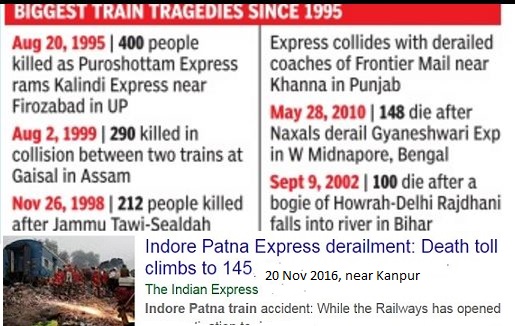
The Times of India and The Indian Express
40% of rail mishaps are at level crossings
The Times of India, Aug 25 2015
40% of rail mishaps are at level crossings
Mahendra Singh
Mishaps at level crossings are the biggest killers, accounting for 40% of train accidents and 66% of fatalities, reflecting the cashstrapped railways' failure to eliminate these crossings by building road-over bridges and road-under-bridges.
The latest data shows that there are 29,487 level crossings, of which around 10,440 are unmanned. Between 2008 and 2015, only 1,344 manned and 7,650 unmanned crossings have been eliminated. In 2015-16, railways targets to get rid of 820 unmanned and 205 manned crossings.
Around 18 accidents on unmanned crossing and three on manned have been reported since April 2015.
Ex-gratia payment for accidents not revised, 1997-2016
IANS, Damages for train accident victims unchanged for 19 yrs', 21 Nov 2016
Even though the cost of living and medical treatment have shot up manifold in the last two decades, the ex-gratia amount given to the kin of those killed in rail accidents has remained unchanged for the last 19 years.
The Rs 4-lakh ex-gratia was fixed way back in 1997, and it continues to be the norm even in 2016. This is in sharp contrast to the previous practice of upward revision of the amount every 10 years or so. For the first time in Independent India, Rs 10,000 ex-gratia was fixed for the families of the dead in a 1962 train disaster, which was doubled in 1963.
[Indpaedia points out that railway fares have not been revised much since 1997 either. Secondly, travel insurance is available for less than Re.1.]
Budget and finances: Railways
2007-10: Discrepancies in railways’ net revenue surplus
Mahendra Kumar Singh TNN The Times of India, Aug 6, 2011
Former rail minister Lalu Prasad’s turnaround of railways from a loss-making to a profit venture was more of a cosmetic exercise, reveals the government auditor’s report.
According to CAG, it was the new practice of issuing a “statement of cash and investible surplus” that helped Lalu project a rosy picture. The auditor has said the innovation helped the former railway minister project a “cash and investible surplus” of Rs 88,669 crore from 2004-2005 to 2008-2009 when the net revenue surplus was only Rs 34,506 crore.
Railways calculated the net revenue surplus after meeting all expenditures, including payment of dividend and appropriation to depreciation reserve fund (DRF) used for renewal or replacement of existing assets.
The ‘cash surplus’ in new presentation indicated the sum generated by railways from operations and other activities, including the interest on fund balance. It shows the money available for paying dividend, appropriation to DRF and other funds for investment. The “investible surplus” was expected to indicate the resources generated annually for capital expenditure after fulfilling the dividend liability.
CAG endorsed the white paper presented by Lalu’s successor Mamata Banerjee in Parliament, which questioned the turnaround story, and pointed out, “this was not accounting change but more in nature of presentation of financial projections from different perspective.”
However, the railways’ finances became worse during Mamata’s tenure as the net revenue surplus saw a sharp decline from Rs 13,431 crore in 2007-08 to Rs 4,457 crore in 2008-09 to a paltry Rs 75 lakh in 2009-10.
Though, CAG mentioned that the poor state of affairs was due to the implementation of the sixth pay commission, which was Rs 37,472 crore during 2008-10, it also blamed the lower growth rate in traffic receipts and increase in working expense.
“During 2009-10, the gross traffic receipt increased by 9%, whereas ordinary working expense grew by 21% over the previous year,” the report cited. Railways efficiency measured by operating ratio (percentage of working expenses to traffic earnings) declined to 95.28% in 2009-10 from 90.46% achieved in the previous year.
Out of 16 zonal railways, eight had operating ratio of more than 100%, which means that their working expenditure was more than traffic earnings. The report reflects that the performance of the railways declined marginally during the last leg of Lalu’s tenure and further worsened when Mamata was at its helm.
Exclusive Railway budgeting to end in 2017
The Times of India, Aug 13, 2016
Mahendra Singh
There will be no separate railway budget from financial year 2017-18, putting an end to a practice that started in 1924, with the finance ministry agreeing to the proposal to merge the transporter's annual exercise with the general budget. Government sources told that the finance ministry has constituted a five-member committee of officers to work out the modalities for the exercise, which will end the annual budget speech+ , often followed closely for project announcements, by the railway minister. The move is significant as in recent years, particularly since coalition governments post-1996, political heavyweights have used the railway budget to hand out goodies and for their own image building. With the railway portfolio often held by regional biggies, the budget reflected political priorities of the incumbent. The railway bureaucracy has also dug in its heels in the past.
Railway minister Suresh Prabhu+ 's readiness to give up the limelight is a break from the past as BJP seems in a position to dump the railway budget as its solid majority in Lok Sabha enabled it to retain the portfolio rather than handing it to an ally.
Once the rail budget is merged with the general budget, railways will be like any other government department that receives budgetary support but comes under the finance ministry's oversight as far as spending and earnings are concerned.
Once the overall funds are allocated, railways will then segregate them for various purposes with sources indicating that the model will be similar to the one for the postal department.
Coach production
Replacing ICF coaches with LHB to take 30 years
Mahendra Singh, Shift to safer LHB coaches may take 30 yrs, Nov 23 2016 : The Times of India
Phasing out of the ICF designed coaches, which piled up during the Kanpur train accident causing death of 150 passengers, will take almost 30 years if the railways moves ahead with the current pace of production of modern Linke Hoffman Busch (LHB) coaches, servicing elite Rajdhani and Shatabdi trains.
Ignoring suggestions of several expert committees which termed the ICF coaches as “safety risk“, the transporter's pace of switching over to LHB coaches has been very slow.
Apart from the inbuilt safety feature of not piling up, the LHB coaches are designed for speeds upwards of 120 kmph, are more fuel efficient and have longer a life span, while the ICF coaches are not meant for speed above 80-90 kmph. After the Kanpur tragedy , the railways is considering to step up the induction of LHB coaches, but a complete transition may take some time. As per the railways' coach production programme, the production units will make 1253 LHB coaches in 2016-17. If the transporter fails accelerate production of these modern coaches, it will take 30 years to replace the ICF coaches which form a large part of its fleet with over 40,000 in operation. At present, only 4,000 LHB coaches are in service.
The transporter is resisting the switch-over process due to poor finances and limited capacity of production units.
Freight corridor, Dedicated railway-
Land compensation issues: 2016
Rail Project Battles Compensation Claims
The dedicated railway freight corridor has finally managed to award all contracts for the Dadri-Mumbai link over 11years after the flagship infrastructure project was announced. But on the eastern front -that will connect Ludhiana with Dankuni in West Bengal -nearly 10% of the land, which is close to 450 hectare, is yet to be acquired even as funding has now been tied up.
For the Rs 81,450 crore project, land acquisition and clearances have been the biggest headache so far. The project needed around 11,600 hectare -6,000 hectare for the western and 4,587 hectare for the eastern stretch. While it was battling court cases and arbitration, a third blow came by the way of the new land acquisition cost, which pushed up the average price from around Rs 1.3 crore a hectare to around Rs 2 crore -an increase of around 54%. Project cost has also been increased as the land acquisition cost rose 75% from the budgeted level of around Rs 8,000 crore to nearly Rs 14,000 crore now . This could go up further depending of the arbitration awards.
In recent years, land acquisition has been a major headache for most infrastructure projects -highways, railways, power generation and special economic zones (SEZs). In several cases, the projects needed to be reworked, if not shelved.
The corridors running across 3,360 km are aimed at building electrified railway system to enable each train to carry a load of up to 13,000 tonnes -which is the load carried by 1,300 trucks. On each corridor, Dedicated Freight Corridor Corporation of India (DFCCIL) is laying double lines, which will treble the average speed of the double-stack goods trains from 25 kmhour to 75 kmhour.While the western leg is funded by Japanese agency JICA, eastern stretch is financed by the World Bank.
“There is no escalation in the project cost. Whatever increase is there is on account of higher cost of land,“ said DFCCIL managing director Adesh Sharma, adding that the project would be fully ready by 2019-end, a year behind the original deadline.
But, before that it needs to battle nearly 2,000 court cases and over 9,500 arbitration awards, of which nearly half are yet to be disposed off. DFCCIL planned the project in a way that it avoided large cities, where land acquisition was going to be a problem. But, challenges have come mainly from areas around the large cities, where prices are higher and “fertile“ agricultural land is being acquired.
Sample this: Nearly half the arbitration cases that are pending are in Haryana (2,277 out of 4,679 cases). When it comes to court cases, Uttar Pradesh tops the list with 669 out of the 1,020 pending cases.
“Most of the arbitration cases relate to compensation based on the latest registration price. Wherever, there is an award, we are paying higher compensation,“ Sharma said.
Freight Policy

Dual Freight Policy struck down/ 2016
The Hindu, June 29, 2016
Dual freight policy for iron ore goes
In a bid to boost freight traffic volumes, the Indian Railways has abolished its dual freight policy for carrying iron ore, a long-pending demand from industry players.
According to a 2008 policy, the tariff for transportation of iron ore to ports for the purpose of exports is three times the rate charged for transporting the same commodity for domestic use in steel and cement industries.
“The dual pricing policy for iron ore transportation was very complicated. From now on, whether you move the iron ore to the plant or to the ports for exports, we will be charging the same,” Railway Board Member (Traffic) Mohammed Jamshed said on Wednesday. Cheering the move, industry representatives said the freight rationalisation will help both Railways and the iron ore sector. “It is a long-overdue move. We had urged the government to bring parity in rates of iron ore transportation irrespective of point of origin and destination,” said Basant Poddar, vice president at Federation of Indian Mineral Industries. A Comptroller and Auditor General (CAG) report tabled in Parliament last year had pointed out that the freight business suffered losses of around Rs 29,000 crore in 2008-13 due to the dual pricing system for transporting iron ore. It had found that iron ore was carried at lower domestic rates but was diverted for exports resulting in huge losses to the exchequer.
Littering at Indian stations: 2013-15
See graphic
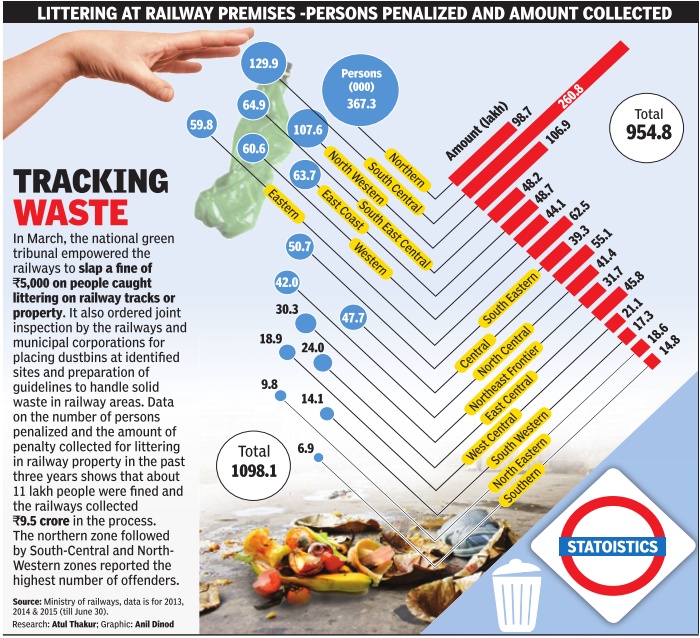
Luxury trains
See graphic.

Passenger traffic
2016: Railways bears 43% of cost
The Times of India , Apr 15 2016
Railways bears 43% of travel cost at a yearly loss of Rs 30,000cr
Mahendra Singh Almost half of the cost of your train travel is borne by the railways. The political cost of doing away with the huge subsidy on passenger fares has prevented the transporter from tinkering with tariff over the years. The railways incurs a loss of Rs 30,000 crore every year in cross-subsi 30,000 crore every year in cross-subsidising passenger fares. “On an average, railways bears 43% cost of your travel,“ says a scroll running on the railways board's portal.
At a time when the transporter is under financial stress, there were expectations that the current leadership with Suresh Prabhu at the helm would revise passenger fares to bring out the transporter out of the financial mess. But, Prabhu seems to have opted for a “politically safe“ path by deferring the matter and leaving the “dirty job“ for the yet to be set up rail development authority .
The minister was of the view that the transporter should first focus on improving its services and try to raise resources through other means. “Whenever you raise fares, there are more questions raised than the rise. Therefore, we are trying to create a new mechanism whereby there will be a proper system that will be put in place (for revising fares),“ Prabhu had said.
Besides failing to meet its annual revenue targets, the railways is faced with an additional burden of Rs 32,000 crore this year towards implementing the 7th pay commission recommendations. Soon, after assuming office in 2014, the BJP government had announced a 14% across-the-board hike in fares, but was forced to roll it bac in sub-urban sector.
A.C. coach traffic vis-à-vis air traffic/ 2016

Domestic air traffic is booming but the travel surge seems to have given the railways a miss, especially in the more profitable air-conditioned classes. While air traffic grew 23% to almost 77 million during April-December, the number of passengers travelling in air-conditioned railway coaches, which touched 108 million, grew at less than 5%.
As a proportion of number of passengers travelling in air-conditioned coaches, air traffic was over 71% (see graph), which is a record. Just a year ago, it was a shade over 60%. As a proportion of AC passenger traffic, domestic air traffic used to hover around the 50% mark until 2014-15.
For Indian Railways, passenger traffic is subsidised by freight or cargo with fares, on an average, covering 57% of the cost. Airconditioned coaches are comparatively less loss-making, although AC three-tier was making profit.
A NITI Aayog analysis showed that a couple of years ago, the railways was spending Rs 1.67 for every rupee earned from its passenger business due to its socalled social obligation.
But a drop in air fares on the back of a fall in global oil prices, together with the railways' experiment with dy namic pricing -which made AC travel more expensive for those booking late -meant that it was more attractive to fly.
Faced with financial stress, the transporter ignored the decline in AC traffic and chose an easier option of introducing flexi-pricing for AC classes to reduce losses, over-looking the suggestions that it should actually hold fares, where it was vulnerable to competition.
Railways, as of now, controls large market share in suburban travel and long distance non-AC travel, but the state-run transporter succumbed to populist pressures and failed to rationalise fares in air-conditioned segments even as it lost shortdistance passengers to luxu ry buses and private vehicles and long-haul to airlines.
The transporter was forced to bear the subsidy of around 64% on suburban travel. While this accounts for 54% of passengers, it yielded just 5.7% of passenger revenues in 2015-16.
The only long-distance segment in which Indian Railways has a large market share is non-AC classes -sleeper and general, but the fare is highly subsidised.The NITI Aayog analysis showed that compared to bus fares, almost 99% of the fare in general coaches is subsidised, while in the sleeper classes the under-recovery is as much as 60%.
So, railways is actually losing a share of the profitable segment.
Railway Board
Reoganisation, 2016
The Times of India, Aug 02 2016
Mahendra Singh
Now, an outside expert in rly board
In a big move to overhaul colonial-era railway bureaucracy , the Modi government has decided to allow lateral entry of external talent for one senior position in the railway board, reorganise the top decision-making body on functional lines and rework the policy of appointments of GMs and DRMs to eliminate discretion.
The Appointment Committee of Cabinet (ACC) decided to create a post of Advisor (resource mobilisation & development) which will be filled through lateral entry , aiming to accelerate the modernisation efforts to revamp the state-run transporter.
The ministerial panel, headed by Prime Minister Narendra Modi, also decided to reorganise the railway board on functional lines by creating post of member (infrast ructure), member (rolling stock), member (traction).
At present, the board has members dealing with different departments such as engineering, traffic, mechanical, and staff apart from the financial commissioner. Over the years, inter-services rivalry has often resulted in blocking of key projects, impacting the government's efforts to upgrade decaying rail infrastructure. While reserving the post of members for different railway services, the panel al so decided to create post of DGs in railway board for three services -personnel, signal and telecom and stores -which don't have representation as members.
In another move, the ACC has decided to discontinue entry of officers through the Special Class Railway Apprentice Examination (SCRA) in Indian Railway Services for mechanical engineers. Started in 1927, the SCRA involved selection to the undergraduate programme in mechanical engineering at the Indian Railway Institute of Mechanical and Electrical Engineering (IRIMEE) at Jamalpur.
Jamalpur graduates -being the youngest to enter railway service -have usually had a disproportionately high share of senior level posts as divisional railway managers (DRMs) and general managers (GMs).
The selection process for GMs and DRMs has also being changed drastically to eliminate discretion in top level appointments which were mired in controversy during the UPA regime due to alleged corrupt practices, highlighted by the arrest of railway board member Mahesh Kumar and delay in filling large number of vacancies.
The DRM posts will be distributed as per strength of railway services and posting will be based on service-wise seniority eliminating the possibility of pick and choose.
Personnel issues
Shortage of staff: 2016
Chethan Kumar, 1.3L Safety Staff Shortfall Derails Rlys, Nov 22 2016 : The Times of India
Existing staff putting in 15 hrs a day
The number of people India loses to train accidents every year could be directly linked to the huge shortage of frontline employees in the “safety category“ of the Indian Railways -1.27 lakh such posts remain vacant as of 2016.
The safety employees, who include trackmen, pointmen, patrolmen, technicians and station masters among others, are directly responsible for the safe running of our trains.And, this crippling shortage of the key force on the ground, experts and unions opine, imperils the lives of passengers.
This has also resulted in the overworking of existing workers, almost all of whom are toiling more than 15 hours a day -leaving enough room for mistakes that could result in grave incidents like the one on Sundaywhich claimed more than 100 lives.
The Railways, which has been more than enthusiastic in spending on `designer uniforms' and other branding exercises, has exhibited nothing but apathy when it comes to filling up safety posts.
As of 2013, the number of such vacancies was 1.42 lakh and in three years, that has only reduced by about 19,500. According to information accessed from the ministry of railways, the national carrier has an overall shortage of 2.17 lakh employees. Of this, 56% or 1.27 lakh are in the safety category.
All India Railwaymen's Fe deration (AIRF) general secretary Shiva Gopal Mishra said, “Where we need three patrolmen, we don't even have one.“
A trackman, for example, says, “I work a 12-13 hour shift on any given day , and more in case somebody takes ill or on days of high maintenance. On an average any trackman needs to carry about 15-17 kg of equipment and we have to work whether it is raining or it is 42 degrees. We have no respite from harsh conditions and the least we hope is that the vacancies are filled up so that we at least get the deserved rest.“
Among the 18 railway divisions, the most such vacancies are in the northern division (14,442), followed by east central (10,034), south eastern (9,967) and central (9,910). The north central division, under whose jurisdiction Sunday's tragedy occurred has a shortage of 9,223 safety employees. Pointing out that the pressure is immense, a loco pilot, who did not want to be named, said, “Depending on the route and division, a locopilot could be driving continuously for 813 hours. The shortage affects us because we are all humans, we become sick, we get tired, and then mistakes can happen. When we have lives of so many people in our hands, you must understand the kind on pressure we work under.“
While the Railways officially maintains that it accords the highest priority to safety with measures like “replacement of overaged assets, adoption of suitable technologies for upgradation and maintenance of track, rolling stock, signaling and interlocking systems et al,“ union members say that the sheer lack of people to implement all these is what is resulting in accidents.
See also
Railways, India: 1

